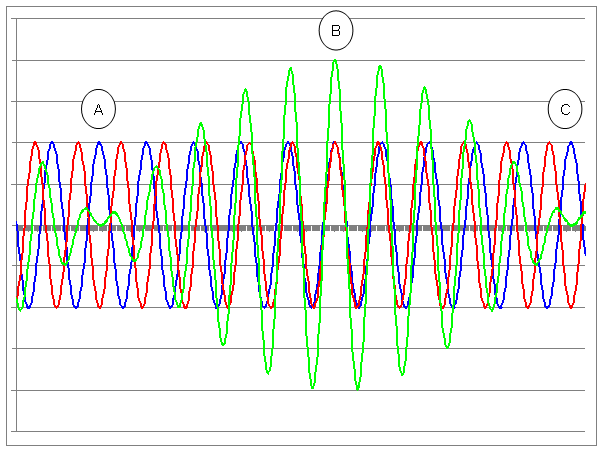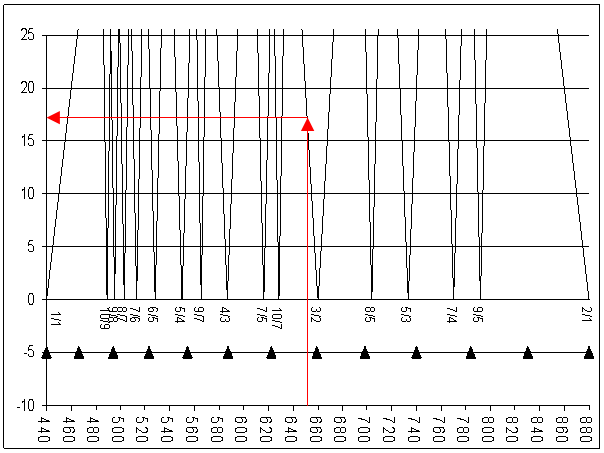
What is the cause of the restless/harsh/exciting sound quality we heard? To understand that, we have to know that a sound consists of waves, each with a pitch, expressed as a number of vibrations per second, hereafter called Hertz (Hz). If two waves, with slightly different pitches, sound at the same time, they are going to interact as shown in the graph below.

The horizontal axis is elapsed time from left to right. The vertical axis represents air pressure changes causing the sound. At point A the blue and red waves move into opposite vertical directions: the blue one has increased air pressure, while the red one has decreased air pressure. The net result is that they cancel out and that you hear nothing - in that short instance (the green wave). But the blue and red waves slowly move into sync at point B, where they reinforce one another (again, the green wave). Furtheron, at point C, they again cancel out, and so on. The alternation of reinforcement and cancelling out is called beating. This alternation happens at a rate which is the difference of the pitches of the two waves that beat.
Let's hear it. The fragment below contains two tones that initially have the same pitch. Then immediately the pitch of one of them gradually shifts until they differ by a semitone. That causes slow beats in the beginning and faster beats at the end.
The following fragment zooms in on the first second, so you can pay attention to the slow initial beating.
Beating can warm up the music, mostly at rates less than 0.5 Hz (i.e. less than one reinforcement and one cancellation in two seconds). At rates of about 7 Hz beating generates a vibrato like effect that can be quite agreeable - if it occurs all the time. If most of the music does not beat, but occasionally and unexpectedly two tones beat at 7 Hz, that can be disturbing. Beating at rates of 10 Hz to 30 Hz sounds restless/harsh. At higher rates the ear cannot track the beating rate: we start to hear the individual tones without any effect of beating.
We heard simple sine waves clearly exposing the beating. So just to compare, you can listen to the following fragments with far more complex sounds. Actually, each tone is 'played' by a chorus of eight synthetic violins with independent vibratos. One chorus continues to play the same tone, the other gradually shifts a semitone up:
And zooming in on the first second:
A little more on complex sounds. When you hear a single cello tone of 220 Hz, you actually hear a mixture of partial sine waves with pitches of 1 x 220 Hz, 2 x 220 Hz, 3 x 220 Hz, etc. The following fragment demonstrates that.
First you only hear the basic sine wave of 1 x 220 Hz. Then one by one sine waves with ever higher pitches are added: 2 x 220 Hz, 3 x 220 Hz etc. In the beginning you may hear the individual sine waves being added, but near the end you likely hear a single tone with a remotely cello-like sound quality.
We are now ready to understand why tones with very different pitches such as C and E can beat as we heard earlier. The C and E in that fragment in 12 tone equal temperament have basic pitches 261.6 and 329.6 Hz respectively. Their beating rate is 329.6 Hz - 261.6 Hz = 68 Hz, too high to be perceived as beating. But check the pitch of the fifth partial sine wave of C: 5 x 261.6 Hz = 1308.1 Hz. And the pitch of the fourth partial sine wave of E: 4 x 329.6 Hz = 1318.5 Hz. Those differ by only 10.4 Hz and that causes the restless/harsh beating.
The graph below specifies the beating rate when two complex tones (such as the cello-like tone we just heard) sound together. One tone has a basic pitch of 440 Hz, the other tone is one with a basic pitch somewhere on the horizontal axis of the graph, i.e. between the A of 440 Hz and the A of 880 Hz. Each V-shaped segment labeled m/n specifies the beating rate of the m-th partial sine wave of the 440 Hz tone and the n-th partial sine wave of the tone whose pitch is on the horizontal axis of the graph. Say we want to know how a 440 Hz tone beats with a 651.5 Hz tone. The red upward arrow shows that. It intersects with the V-shape labelled 3/2. That means that 440 x 3 = 1320 Hz beats with 651.5 x 2 = 1303 Hz. The difference between these numbers is a beating rate of 17 Hz. The red horizontal arrow shows that.

This version of the graph is limited to combinations of the first ten partial sine waves of any tone. Hence the highest numbered labels 10/9 and 10/7. Ten is an arbitrary number here, we could have gone much higher. But there are reasons why pitches of ever higher numbered partial sine waves are less important for beating:
The black triangles represent an octave of ordinary 12 tone equal temperament. You may notice that the black triangle closest to the 5/4 V-shape would have a red arrow leading to quite a high beating rate (17.5 Hz actually). The same holds for the 5/3 V-shape (20 Hz beating rate) and some others. Such beating rates may sound quite annoying.